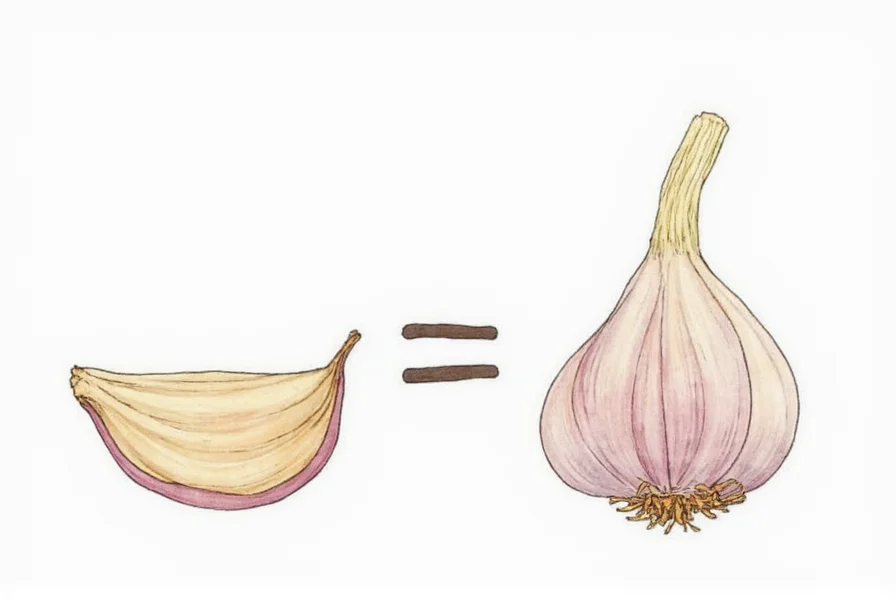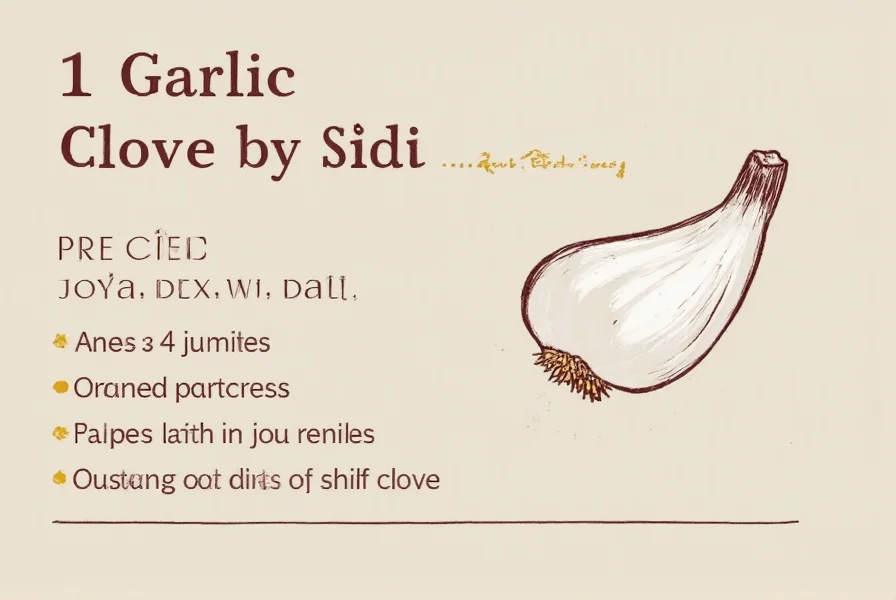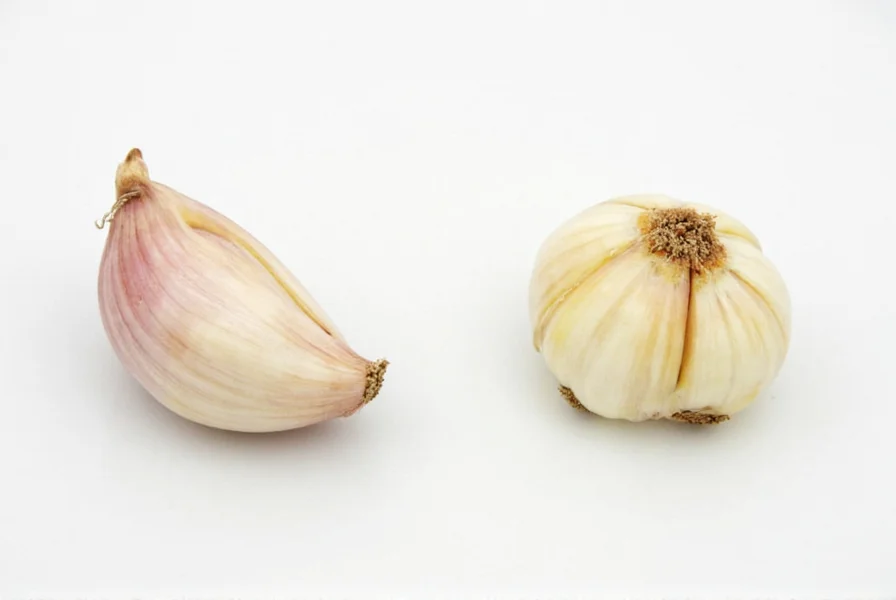Understanding precise garlic measurements transforms your cooking experience. Many home chefs struggle with recipe instructions that call for “one garlic clove” without providing equivalent measurements. This guide delivers accurate conversions and practical usage tips for working with single garlic cloves in your kitchen.
Garlic Clove Measurement Conversions
Garlic measurements vary based on preparation method and clove size. The following conversion chart provides precise equivalents for one average-sized garlic clove:
| Preparation Method | Equivalent to 1 Garlic Clove | Notes |
|---|---|---|
| Minced | 1/2 teaspoon | Finely chopped, most common preparation |
| Chopped | 1 teaspoon | Roughly cut pieces |
| Garlic Powder | 1/8 teaspoon | Use for dry rubs or when fresh isn't available |
| Garlic Paste | 1/4 teaspoon | Commercial paste or homemade |
| Garlic Salt | 1/4 teaspoon | Reduce additional salt by 1/8 teaspoon |
Factors Affecting Garlic Measurements
Several variables impact the actual volume of “one garlic clove” in your recipe:
- Clove size – Garlic varieties range from small (1/4 teaspoon minced) to jumbo (1 teaspoon minced)
- Preparation technique – How finely you mince affects volume and flavor intensity
- Freshness – Older garlic dries out, reducing volume while concentrating flavor
- Moisture content – Water content varies by growing conditions and storage
For professional results, consider using a kitchen scale. One medium garlic clove typically weighs 3-7 grams depending on variety and moisture content.

Practical Applications in Cooking
Knowing “how much is one garlic clove” helps you adapt recipes confidently. When a recipe calls for “one garlic clove,” consider these factors:
For sautéing, one minced garlic clove works perfectly in dishes serving 2-4 people. Add it to hot oil just before other aromatics to prevent burning. For roasting, leave the clove whole—its natural sugars caramelize beautifully. In raw applications like salad dressings, one garlic clove provides noticeable but not overwhelming flavor.
When substituting dried garlic products for fresh, remember that garlic powder measurement for one clove requires careful adjustment. Dried garlic has more concentrated flavor, so use less than fresh equivalents would suggest.
Preparing a Single Garlic Clove Properly
Many cooks waste garlic by improper preparation. Follow these steps for maximum yield from one garlic clove:
- Place the clove on a cutting board with the flat side down
- Gently press with the palm of your hand to loosen the skin
- Peel away the papery skin
- Trim the root end without removing excessive flesh
- For mincing, slice thinly first, then rock your knife back and forth
This technique ensures you get the full 1/2 teaspoon minced garlic equivalent from a standard clove. Avoid common mistakes like burning garlic during cooking or using too much when substituting dried products for fresh.
When to Adjust Garlic Measurements
While standard conversions work for most recipes, certain situations require adjustments to the typical “one garlic clove equals” measurement:
- Delicate dishes – Reduce to 1/4 teaspoon minced for subtle flavor in fish or light sauces
- Strong-flavored dishes – Increase to 1 teaspoon minced for robust stews or meat dishes
- Garlic sensitivity – Some people metabolize garlic differently; adjust to personal tolerance
- Recipe age – Older recipes often assume smaller garlic cloves than modern varieties
Understanding these nuances helps you master recipes calling for “one garlic clove” regardless of your specific ingredients.
Substituting for Fresh Garlic
When you need garlic conversion for one clove but lack fresh garlic, these alternatives work well:
- Garlic paste – Use 1/4 teaspoon per clove (check sodium content)
- Garlic powder – 1/8 teaspoon equals one fresh clove (ideal for dry rubs)
- Garlic salt – 1/4 teaspoon per clove (reduce additional salt by 1/8 teaspoon)
- Pre-minced jarred garlic – 3/4 teaspoon per clove (flavor differs from fresh)
For authentic flavor, fresh garlic remains superior, but these substitutions help when working with limited ingredients. Remember that garlic powder equivalent to one clove requires less quantity than fresh due to concentration.

Common Garlic Measurement Mistakes
Cooks frequently make these errors when working with single garlic cloves:
- Using entire heads when recipes specify cloves
- Not adjusting for clove size variations
- Burning garlic by adding too early in cooking process
- Using equal volumes of dried and fresh garlic
- Peeling too aggressively and wasting edible portions
Avoid these pitfalls by understanding that “one garlic clove measurement” isn't universal—it depends on preparation and recipe requirements. When in doubt, start with less garlic; you can always add more but cannot remove excess.
Conclusion
Mastering garlic measurements elevates your cooking precision. Remember that one medium garlic clove equals approximately 1/2 teaspoon minced, 1 teaspoon chopped, or 1/8 teaspoon garlic powder. Consider clove size, preparation method, and recipe context when converting measurements. With this knowledge, you'll confidently handle any recipe calling for “one garlic clove” and achieve perfectly balanced flavors every time.
Frequently Asked Questions
How much minced garlic equals one garlic clove?
One medium garlic clove equals approximately 1/2 teaspoon of minced garlic. Smaller cloves may yield 1/4 teaspoon while larger ones can produce up to 1 teaspoon of minced garlic.
Can I substitute garlic powder for one fresh garlic clove?
Yes, you can substitute 1/8 teaspoon of garlic powder for one medium fresh garlic clove. Remember that dried garlic has more concentrated flavor, so use less than fresh equivalents would suggest.
Why do recipes specify garlic cloves instead of measurements?
Recipes often specify garlic cloves because size varies significantly between garlic varieties. This allows cooks to adjust based on the actual cloves they have, though precise measurements provide more consistent results.
How do I prevent burning garlic when cooking?
Add minced garlic to hot oil for just 30-60 seconds before adding other ingredients. Garlic burns easily—it should become fragrant but not brown. For whole cloves, roasting at 375°F (190°C) prevents burning.
Does the size of a garlic clove affect flavor intensity?
Yes, larger cloves often have milder flavor while smaller cloves can be more pungent. However, freshness and variety affect flavor more than size alone. Older garlic develops stronger, sometimes bitter flavors regardless of size.











 浙公网安备
33010002000092号
浙公网安备
33010002000092号 浙B2-20120091-4
浙B2-20120091-4